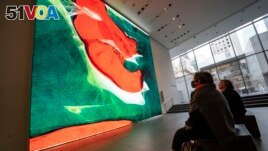23 January 2023
Artificial intelligence (AI) systems are using imaging information from paintings and photographs to create new images in the same style. DALL-E, Midjourney and Stable Diffusion are among the AI tools that can create images that copy the styles of real artists.
A user can ask the system to produce an image, such as "a cat in the style of Van Gogh," and the AI tool will quickly do so.
That makes living artists worry that their works will be copied without their permission. Two new legal actions, or lawsuits, have been brought against the AI companies creating the images.

Visitors view artist Refik Anadol's "Unsupervised" exhibit at the Museum of Modern Art, Wednesday, Jan. 11, 2023, in New York. (AP Photo/John Minchillo)
Getty Images has brought one of the lawsuits. The American company is based in Seattle, Washington. It owns the rights to millions of pictures and other images.
Getty is accusing London-based company Stability AI of violating Getty's copyright. Copyright protects works of authorship, including images and artworks. The owner can sell the work or permit others to use it.
Three working artists also took legal action this year against Stability AI, and the companies Midjourney and DeviantArt. The artists say the companies' AI images unfairly "compete in the marketplace with the original images."
Midjourney CEO David Holz recently spoke to The Associated Press about the issue.
"Can a person look at somebody else's picture and learn from it and make a similar picture?" he asked, adding "it's allowed for people and if it wasn't, then it would destroy the whole professional art industry."
Real versus fake images
The lawsuits come at a time when there is growing concern about new AI tools. These include systems that create readable text, music, computer code, and images. Some experts worry that AI technology could get too good, including engineer Wael Abd-Almageed.
"Once we lose this capability of telling what's real and what's fake, everything will suddenly become fake because you lose confidence of anything and everything," he said. Abd-Almageed teaches electrical and computer engineering at the University of Southern California.
However, some artists welcome the AI systems as new tools for creativity.
There is a lot of room for fear, but "what else can we do with them?" asked artist Refik Anadol, who uses AI to create.
In New York City, Anadol's work "Unsupervised" is on show at the city's world-famous Museum of Modern Art. The large installation represents the many artworks at the museum through a constantly changing image based on AI.
But Anadol hopes future uses of AI will permit artists to choose whether their art be included in new creations.
"I totally hear and agree that certain artists or creators are very uncomfortable about their work being used," he said.
I'm Andrew Smith.
Matt O'Brien and Arijeta Lajka wrote this story for The Associated Press. Andrew Smith adapted it for VOA Learning English.
______________________________________________________________
Words in This Story
style -n. the form or design common to a particular artist or period or group of people
authorship -n. the origin of, especially the creator of, original creative works
transformative -adj. characterized by change from one thing or state into another thing or state
allow -v. permit
text -n. printed words
code -n. the set of instructions that make a computer program work
capability -n. the ability to do something
fake -adj. not genuine
confidence -n. the belief or feeling of that one will achieve a desired result
installation -n. a display of art for public viewing
uncomfortable -adj. somewhat worried or in physical discomfort